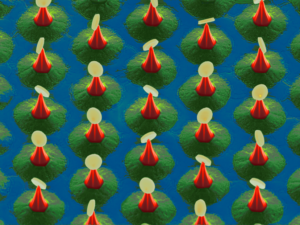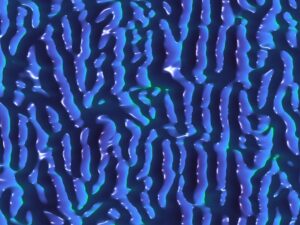Congratulations to the winners of the STS Elionix Scientific Image competition of Q2 2024!
The STS Elionix Scientific Image competition allows us to showcase the creative side of the researchers here at Tyndall. They share scientific images from their research which they have discovered to be visually striking or informative to the technically excellent.
The judges for the Q2 competition were Prof. William Scanlon, CEO; Dr Graeme Maxwell, Head of Specialty Products & Services; Peter Smyth, Commercial Director; Dr Daniela Iacopino, Researcher, MNS.
The exceptional quality and creativity in the three images led to the votes being cast for the following winners: Vitaly Zubialevich (Ladies in Red), Padman Narayanasamy, Irish Rohra (Gold Leafy Cobaltets) and Xing Ouyang (Information Waves).
The winners are each awarded a €100 Me2You Gift Card, kindly sponsored by STS Elionix.
Ladies in Red
Vitaly Zubialevich, III-Nitride Materials Group

This scientific image shows SiN disks GaN capped with nanorods after an excessive thermal annealing. Exposure of GaN to high temperatures in ammonia and nitrogen ambient is used as subtractive annealing for its controlled thermal etch. Too high temperature and/or too long duration of the annealing results in too much of the nanorod body material decomposing and subliming.
In this image, the exact moment (a lucky combination of temperature and time) is captured when the diameter of the nanorods decreases down to zero. This occurs because the SiN caps cannot preserve their original orientation (parallel to the “ground”) but (being still held by van der-Waals forces) tilt at random angles.
The residual shapes of GaN nanorods after the fake colourisation bear some resemblance to people in long red cloaks.
Gold Leafy Cobaltets
Padman Narayanasamy, Irish Rohra, Nanotechnology Group

This scientific image illustrates a Scanning Electron micrograph portraying cobalt nanoarchitecture on a gold micro-electrode.
This image was developed for the purpose of glucose sensing.
Within the framework of the Summer Fellowship Programme and project ‘Hierarchical hetero-nanostructured catalyst for non-enzymatic glucose sensing’, the goal is to create a nanostructured catalyst to facilitate non-enzymatic glucose sensing for the purpose of commercial food product analysis.
Information Waves
Xing Ouyang, Photonic Systems Group

This image illustrates the so-called Fading Effect in wireless communication systems which usually happens in a typical outdoor environment surrounded by dense buildings.
The fading effect looks like the endless waves of the Atlantic Ocean, and the fluctuation of these waves indicates the strength of the radio frequency signals. This is due to the fading effect over time (horizontal) and frequency (vertical) dimensions. That’s why it called Information Waves.
This fading effect is caused by both the small-scale scattering effect of a single RF signal path, created by surrounding buildings/objects and the multiple delayed transmission signal paths due to large-scale reflections. The construction and destruction of the combined scattered and reflected signal paths lead to the up and down pattern of the signal strength received by our cell phones.
